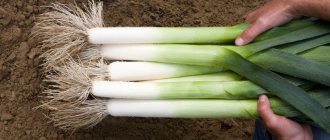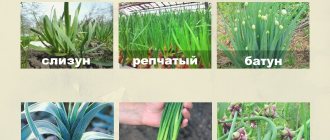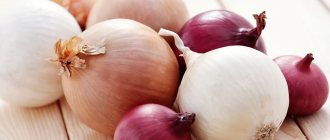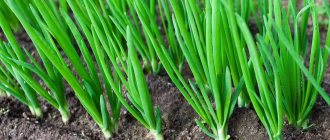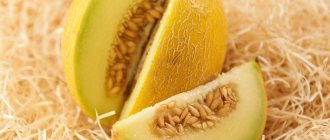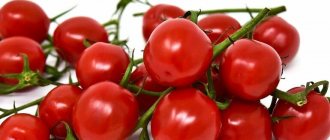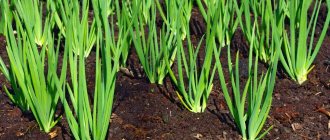Shallots are a popular garden crop, which, with proper care, is quite capable of competing with its onion counterpart in terms of benefits and productivity. Shallots are great for fresh consumption and canning. And the tender and juicy greens of the plant will enrich your diet with vitamins.
How to harvest a rich harvest of tender, juicy onions with a piquant, sweetish taste already in July? Very simple! As soon as the last spring frosts have receded, we plant bulbs of any of the varieties of the “Family” variety of shallots in the garden bed. After only 100-120 days we enjoy the fruits of our own labor.
Description and photo of the Family Onion
Family (Semeyka, Gnezdovka, Kushchevka, Zubovka) is a multi-primed variety of onions called shallots. It is a perennial plant that forms from 4 to 10 bulbs formed into a nest. Their size and quantity depend on the growing conditions and the variety of crop.
Reference. The size of one Semeika bulb, as a rule, does not exceed 5 cm, and the total weight of the nest reaches 500 grams.
The green part of the plant represents the feathers. They are thin, tubular and round in shape. Each bulb produces up to 10 feathers of fresh greenery, capable of reaching up to 40 cm in length.
Origin and development
The plant got its name due to its ability to grow entire families of bulbs formed into a single nest.
Shallots were cultivated and began to be used as food by humans more than a thousand years ago . The first mention of this plant came to us from the city of Ascalon, once located in ancient Palestine. The exact place of origin of the culture is not known for certain. However, historians believe that the birthplace of the modern Family is in Asia Minor. A plant similar in description was mentioned in local ancient chronicles.
Reference. Until recently, shallot varieties were cultivated only in areas with a warm climate: in Egypt, Georgia, Greece, India, Kazakhstan, and the Kuban. But breeders have developed more cold-resistant varieties of Semeyka, which made it possible to grow it in regions with more severe climatic conditions.
The family has fundamental differences from other varieties of onions:
- Multi-primed varieties form nests consisting of 3-10 bulbs. Their weight ranges from 20 to 80 g depending on the variety.
- Shallot feathers are thinner and rounder, and also less sharp at the tips, than those of ordinary onion varieties.
- The greens have a pronounced waxy coating on the surface.
Origin story
According to scientific research, culture appeared more than 4000 BC.
The first mentions of turnips can be found when studying the history of Asian countries. Bulb was brought to Rus' through the Danube River, where the Slavs were actively engaged in trade with Europeans, immigrants from the Caucasus and Central Asia. It was in those days that the description of onions as a vegetable with disinfecting and healing qualities first appeared. Travelers often took garlic and onions with them on the road. After the plant became widespread in Russia, domestic breeders developed many varieties. Onions with different characteristics in taste, color, size are available in a huge assortment.
Onion beds remain unchanged in Russian summer cottages
Varieties of heirloom onions
Today there are more than 50 different varieties of Kushchevka, differing in the following characteristics:
- precocity;
- frost resistance;
- degree of sweetness of the bulbs.
Early ripening
Early ripening Semeyka varieties are ideal for cultivation in regions with harsh climates, producing crops even in short and cool summers.
Emerald
Semi-sharp tasting variety. It has round-shaped bulbs, located 3-4 pieces in a nest. The weight of each reaches 15-22 grams. The husk is brownish-pink. Productivity - up to 1.5 kg per 1 m². Keeping quality is good - up to 10 months at home. The culture is biennial.
Snowball
Snowball is a spicy-tasting variety of shallot. The bulbs reach 30 g and are ovoid in shape. The husk is off-white, the juicy part is snow-white. When properly grown, it produces up to 2 kg of yield per 1 m². Shelf life - up to 7 months.
Sprint
The optimal variety of early ripening onions for obtaining vitamin-rich greens is Family. The bulbs are soft yellow with a pink tint and have a pronounced pungent taste. The weight of one varies from 20 to 35 g. Technical ripeness occurs at the end of July.
Mid-season
Mid-season shallot varieties are represented by the largest number of varieties. They are characterized by high yield and large bulb size. Recommended for cultivation in the southern regions. Suitable for cultivation in the middle zone subject to a long period of warmth.
Albik
A mid-season variety characterized by a semi-sharp taste. The bulbs have a round, slightly flattened shape, weigh up to 10-30 g. There are from 3 to 8 pieces in one nest. It is characterized by stable and high yield, and can be stored well even at home.
Interesting. Despite the relatively small size of the bulbs declared by breeders, some amateur gardeners manage to obtain heads reaching 3 cm in diameter. This indicates the great prospects of Albik for cultivation in the regions of the middle zone.
Kuban yellow
The variety is characterized by semi-sharp-tasting bulbs, arranged in a nest of 4-6 pieces. Shape - from round to round-flat, weight - 20-30 g. The color of the husk is brownish-yellow. The juicy part is white with a pronounced greenish tint. Keeping quality is good.
Koinarsky
A semi-sharp variety that produces 2 to 4 bulbs in a nest. They have a round, flattened or oval shape. The weight of one turnip is about 25 g. Dry scales are pinkish-brown in color. The juicy part is light lilac with white stripes. The growing season is just under 3 months.
Late ripening
Late-ripening Semeyka varieties are characterized by a longer period of technical maturity. In this regard, their cultivation is possible only in regions with a long summer period.
Kunak
The variety is characterized by high ripening before harvesting. Developed at the Krasnodar Research Institute of Vegetable and Potato Farming and recommended for cultivation in the North Caucasus region of the country. The period of technical maturity is 80-110 days. The bulbs have a round, flattened shape. The weight of one is from 25 to 30 g. The husk is yellow. The juicy part is snow-white. The plant forms 3-4 buds per nest.
Sturdy
A semi-sharp variety of shallot. Oval bulbs are covered with soft pink scales and are formed 4-7 pieces per nest. Weight - from 20 to 50 g, depending on climatic conditions and cultivation methods.
An important difference of the variety is its high resistance to rot, as well as the formation of bolts. This family onion is suitable for autumn seed planting before winter.
Siberian amber
Biennial variety. The bulbs form 6-7 primordia in a nest. They are covered with golden-yellow scales, have a round shape, high density, weigh from 20 to 30 g. The pulp is juicy, semi-sharp in taste. The yield of the variety is up to 1.5 kg per 1 m².
a brief description of
The appearance of shallots is associated with its spread from Central and East Asia. The name of the vegetable comes from the ancient city of Ascalon. Over time, the word transformed and came to us in the form of the now familiar “shallot”.
How does it grow?
Ripe shallots are similar to garlic. The similarity between the plants is given by the large number of shallot segments. The bow consists of two parts - above ground and underground. The underground part has the usual shape of bulbs, and the above-ground part has green leaves. Shallot feathers are thin, delicate in taste and very aromatic.
What does it look like?
Shallots are similar in appearance to ordinary onions: they are also covered with a reddish or light purple husk, and their inner petals are the same white-cream. However, it is impossible to confuse the two types: shallots have an unusual oblong shape, which makes them different from other onion varieties. The bulbs have a smooth surface, are elastic, have a crunchy texture and a sweetish smell.
How much does one onion weigh?
Recipes often indicate the amount of ingredients in grams; it will be useful to know how much a head of shallot weighs. The weight of an average onion is 30-32 g.
Taste
Many people love shallots for their taste. © https://ydoo.info/product/luk-shalot.html The delicate, soft, bitter taste of onions will appeal to real gourmets.
How they eat?
You can enjoy the taste of shallots in different ways: eat the chopped head just like that, add it to a salad, serve it as a first course, make a sandwich, or cook a main course with this onion.
frame class=”lazy lazy-hidden” title=”Shallots – a gourmet delight
Chemical composition and beneficial properties
100 g of Family onion contains:
- water - 79.8 g;
- ash - 0.87 g;
- saturated fatty acids - 0.017 g;
- potassium - 334 mg;
- phosphorus - 60 mg;
- calcium - 37 mg;
- magnesium - 21 mg;
- sodium - 12 mg;
- iron - 1.2 mg;
- zinc - 0.4 mg;
- manganese - 0.292 mg;
- copper - 88 mcg;
- selenium - 1.2 mcg;
- chromium - 0.8 mcg;
- cobalt - 0.05 mcg;
- vanadium - 0.03 mcg.
Of all the varieties of onions, only shallots contain selenium, chromium, vanadium and cobalt.
Vitamin composition of nesting onions per 100 g:
- vitamin C - 8 mg;
- pyridoxine (B6) - 0.345 mg;
- pantothenic acid (B5) - 0.29 mg;
- niacin equivalent (PP) - 0.2 mg;
- thiamine (B1) - 0.06 mg;
- riboflavin (B2) - 0.02 mg;
- vitamin RE (A) - 60 mcg;
- folic acid (B9) - 34 mcg.
The nutritional value of the product is characterized by the following indicators per 100 g of product:
- 72 kcal - 3.6% of the norm for an adult;
- carbohydrates - 16.8 g;
- proteins - 2.5 g;
- fats - 0.1 g.
Thanks to the phytoncides contained in Family onion, it is widely used in folk medicine to cleanse the body of various viruses, bacteria and parasites. When onions are eaten, its pulp enters the digestive tract, neutralizing the bacterial flora and enhancing intestinal motility. This promotes the effective removal of toxins from the body.
The potassium, magnesium, sodium and some vitamins contained in the Family improve the functioning of the circulatory system and improve the hematopoietic functions of the body. By increasing the elasticity of the walls of blood vessels, blood pressure is normalized and the heart muscle is strengthened.
Vitamins and antioxidants contained in all edible parts of shallots provide effective rejuvenation of the body.
Regular consumption of fresh herbs and Semeika bulbs:
- improves metabolic processes in tissues;
- neutralizes free radicals;
- removes toxins and excess cholesterol.
The potassium contained in nesting onions helps the body regulate water-salt balance and maintain muscle tone. In addition, Semeyka is recommended to be used to combat obesity, as well as its consequences.
Ripening period
All varieties of the Family variety are characterized by early ripening compared to ordinary onions. Depending on the plant chosen for planting and climatic conditions, harvesting begins within 60-120 days. The feathers for greens are cut 1-2 weeks after planting the sets and a month after sowing using the seed method.
Productivity
By strictly observing the regionality recommended for a particular variety and having studied the agricultural technology of its cultivation, you can collect up to 1.5 kg of Family bulbs from each square meter of crops.
Attention. The yield declared by the seed manufacturer is reduced due to plant damage by insects or various diseases. Therefore, at all stages of the growing season it is important to take preventive measures.
Disease resistance
All varieties of shallots are characterized by increased resistance to rot and fungal diseases.
Characteristics of the bulb, description of appearance, taste
Depending on the specific variety, Semeiki have a sweet, medium-hot, spicy and even bitter taste. The size and shape of the bulb, the color of the husk and the juicy part also depend on its varietal.
General features characteristic of the Family Bow:
- the size of the bulbs is relatively small - from 4 to 7 cm;
- elongated or slightly flattened shape;
- the color range of the husk varies from yellow-brown to red and even pink-violet;
- the edible part of the bulbs is dense, juicy and aromatic;
- weight - from 20 to 80 g, depending on the variety and agrotechnical growing conditions;
- high degree of frost resistance and excellent shelf life.
For which regions is it recommended?
Choose planting material for cultivating shallots taking into account climatic conditions. There are more than fifty varieties of Semeika, suitable for cultivation in the south of Russia and in central Russia.
Attention. When planting in midland regions, choose early-ripening shallot varieties. This will ensure the crop reaches full technical maturity before the first frost.
Problems in care
Family onions are considered a very unpretentious crop. It is very resistant to pests and tolerates temperature changes well. There is no active growth of weeds in his beds. But sometimes these plants also need help. What problems do gardeners most often see with growing different varieties of heirloom onions?
The onion feather turns yellow
Why is this happening? If family onions turn yellow, this is a sign of a lack of nutrients in the soil.
Solution. Feed. You can add a solution of potassium salt (10 g per 10 l of water), ammonium nitrate (10 g per 10 l of water) to the substrate. If you do not want to resort to mineral fertilizers, replace them with wood ash, litter or manure.
The main advantages and disadvantages of family onions
Main advantages:
- Semeika bulbs are more frost-resistant and have a high shelf life even at home.
- The taste of most varieties is delicate, which allows them to be widely used in cooking.
- Family onions are characterized by consistently high yields and are rarely affected by diseases, unlike their onion counterpart.
Flaws:
- Peeling small shallot bulbs is quite inconvenient.
- The crop is characterized by low resistance to damage by onion flies and other insects.
Features of planting and growing
The process of cultivating shallot varieties is practically no different from growing ordinary onions. Nevertheless, there are some agrotechnical nuances and tricks.
Preparing for landing
Before planting Semeika, it is necessary to properly prepare the seedlings:
- To do this, the bulbs are cleaned of old dried husks and kept in a solution of copper sulfate (1 tablespoon per bucket of water) for 10-15 minutes.
- After preventative soaking, the bulbs are rinsed with clean, cool water.
- To restore the supply of nutrients lost during storage in planting material, soaking it for 10-12 hours in any specialized nutrient solution: “Kornevine”, “Epine”, etc. will help. To increase the efficiency of such processing, it is recommended to carefully cut off the heel of the bulbs, ensuring more easy access of moisture to the juicy part.
- To ensure that the buds in the nest reach the maximum possible size, the bulbs prepared for planting are cut. Each contains 8 rudiments. By dividing the bulb in half, you will get two full nests of 4 bulbs each. In this case, the vegetables will reach a larger size than in an undivided family.
Soil requirements
Shallot is undemanding to the soil, but its acidity should be neutral. Most of all, onions love moist sandy or loamy soils rich in humus. For planting, it is better to choose a place that has recently been cleared of legumes, carrots or potatoes.
Dates, scheme and rules of planting
Family onion is a cold-resistant plant. Its roots successfully survive temperatures down to -7°C. However, it is not recommended to plant shallots before the night frosts have subsided, as low temperatures will cause them to bolt. The exception is varieties suitable for winter planting.
The optimal time for sowing Semeika is considered to be mid-April - early May, depending on weather conditions and the region.
Each bulb forms a nest with a dense aerial part. If the shallots are crowded, they will grow small and sickly. The main condition when planting rudimentary onion varieties is strict adherence to the distance between future plants.
The optimal planting pattern is in rows, the distance is at least 10 cm. When planting large varieties, this figure is increased to 30-40 cm. Medium-sized varieties will require 15-20 cm between each ridge. Planting depth - 3-4 cm.
Soil poor in nutrients is fertilized before planting onions. Rotted compost is placed in each hole, 1 tsp. superphosphate, urea and 2 tbsp. l. ash.
Features of cultivation: watering regime, loosening, weeding and fertilizing
High humidity and warmth are the key to a rich harvest of shallots. The air humidity in the beds should be at least 60%, and the soil - even more. Throughout the growing season, plants are watered at least once a week, constantly keeping the beds slightly moist.
If the soil is breathable (not loam), additional loosening of the beds is not required.
To maintain an optimal level of humidity, onion plantings are mulched with straw, laid out in a layer of 7-10 cm. This procedure will also reduce the number of necessary weedings, which, in the absence of mulch, are carried out regularly.
Fertilize only moist soil. Twice a month it is recommended to apply 30 ml of ammonia diluted in 10 liters of water under the roots of plants.
To increase soil fertility, plants are fed with urea. This is done when the first 3-5 leaves grow. 30 g of urea and 15 g of potassium sulfate are diluted in 10 liters of water. After 14 days, fertilizing is repeated by adding potassium monophosphate to the solution.
Disease and pest control
Rudimentary onions are practically not susceptible to fungal diseases and rot, so to prevent them it is quite enough to treat the planting material (for example, with a solution of potassium permanganate).
The most dangerous pests for Semeyka crops are:
- Onion fly. The phytoncides secreted by ordinary garden carrots will help scare it away. Early planting of planting material will help protect plantings from onion flies. In this case, by the time the first insects appear, the feathers will have time to become coarser. Another method of control is to mulch the beds with tobacco dust, peat, ash or onion peels.
- Onion hoverfly . Methods for controlling this harmful insect are similar to methods for protecting shallots from onion flies.
- Onion moth . The main preventive measures are compliance with crop rotation and timely mulching of beds with tobacco dust, ash, peat or onion peels.
- Medvedka. The best way to fight is to set traps. To organize them, small piles of manure are laid out on pieces of plywood or boards. The mole cricket will lay its eggs there, which are burned along with the bait every 7-14 days, laying out new manure in the same place.
THE BEST WAY TO PROTECTION against caterpillars, colorados, moths, weevils, carrot, onion and cabbage flies!
Advice from experienced summer residents
- If you purchased heirloom onion seeds, be sure to prepare them before planting them in the ground. Take a cloth (or gauze) bag, place the seeds there, and then place the bag in a saucer of water to soak for 48 hours. Change the water in the saucer periodically. Then the seeds must be dried so that they are free-flowing. Now they can be sown in furrows, maintaining a distance of 8 centimeters. Leave 15 centimeters between these grooves. One seed should produce two to four small onions. This is how you will grow your own family onion sets, which can be used as planting material next year.
- If you bought a set, then before planting, disinfect it in warm water, to which crystals of potassium permanganate have been added. You can do the following preliminary preparation of planting material before sending it to the beds:
- keep the dried onions in a salt solution for 3 hours (take 60 grams of salt for two liters of water), then rinse the onions;
- place the bulbs in a dark solution of potassium permanganate for two hours, then rinse and dry.
- If you have little planting material, you can try planting in halves (or even quarters). Bulbs with a diameter of 3 centimeters and a weight of 30-40 grams are suitable. Cut off the dry neck of each and trim the bottom to fresh roots. The bottom of this onion is covered by a woody “heel”, so it must be carefully trimmed so that later many roots appear on the onion. Soak the prepared onions in water overnight. Immediately before planting in the ground, cut these bulbs into halves (or quarters). Make a cut along the onion using a sharp knife. Attention! In this type of onion, the roots are located unevenly on the bottom, so cut so that approximately the same number of roots remain on each plot (half or quarter).
- To get good bulbs, plant on the days of the waning moon. If you need greens, then choose days for planting when the Moon is waxing.
- To prevent widespread onion fly spread, alternate rows of onions and carrots.
- It is undesirable to add fresh organic matter when growing onions, otherwise the greens will be massive, but the quality of the bulbs will deteriorate, they will turn out loose and unsuitable for winter storage.
- Do you want to get large onions? Then normalize the number of heads in the “family”, do not thicken the plantings. Rationing is carried out by raking out the earth and unscrewing some heads. In the future, use these removed heads with green feathers for food, and the remaining “tenants” in the nest will gain freedom and gain weight.
We hope that the knowledge gained about heirloom onions will help you grow tender, vitamin-rich greens and strong, well-stored bulbs that have medicinal and dietary properties.
You may also find the following materials useful:
- How to care for potatoes after planting
- The radish harvest will be generous if you know some secrets! We talk about all the nuances of growing tasty and juicy radishes in the garden bed
- How to water cucumbers to make them grow and bear fruit faster
- The beet leaves are turning yellow and drying! How to save a root vegetable and preserve the harvest of a healthy vegetable
- How to properly pick the stems of tomatoes. When to pick tomatoes in 2022 according to the lunar calendar
Harvest and storage
The multi-bud onion is harvested when more than half of its greenery has fallen. In most regions this occurs in late July - early August.
Attention! There is no point in delaying the collection of shallots that are already more than half withered. Its bulbs will begin to take moisture from the soil, thereby reducing their maximum shelf life.
They are collected in dry sunny weather, and 1-2 days before the start, watering the ridges is completely stopped.
The nests are carefully dug out entirely and laid out to dry during daylight hours right on the ridges. When the crop dries, the feathers are cut off and undamaged bulbs are selected for long-term storage.
The shelf life of Semeyka onions is high: 6-10 months depending on the specific variety. The optimal place to store shallot harvest is in well-ventilated boxes placed in a warm, dark, dry room.
The rudimentary onion is an unpretentious plant. The main difficulties are early bolting when temperature conditions are violated and damage by various pests.
Top dressing
This crop tolerates fertilizing well. Several types of fertilizers can be used. An organic and safe option that gives great results is bird droppings. Dilute it in proportions of 1:15 with water. Another good option is mullein. It is diluted in water in a ratio of 1:10.
You can also use mineral fertilizers. These can be either universal complex fertilizers or specific substances (superphosphates, potassium). All mineral fertilizers must be prepared according to the instructions specified by the manufacturer on the packaging. The universal formula for mineral fertilizers is the following proportion: 40 g of product per bucket of water (10 l).
Tips to note:
- During the period of intensive growth, onions are watered once every 3 days.
- If the weather is cloudy, but without rain, then watering is done once every 7 days.
- Want to know how to grow big heirloom onions? You need to loosen the soil 1-2 times a week
- Planned thinning of onions in the first ten days of July will help you get an excellent harvest.
- The ideal type of mulch in the summer season is freshly cut grass.
- If the onion is affected by pests, you need to spray it with a raster based on Bordeaux mixture
- After treatment with Bordeaux mixture, greens are not eaten for 5 days.
- Treatment should not be carried out 14 days before harvesting the bulbs.
- Fertilizers must be applied no later than 30 days before harvest. Then the onion will begin to gain the volume of the bulbs and stop the intensive growth of greenery.
Advice from experienced gardeners
Experienced gardeners recommend reducing the number of buds in each of the bulbs prepared for planting by dividing them. This will allow you to get large bulbs in each of the nests.
It is recommended to update planting material at least once every 4 years. Shallot is a biennial plant. After this period, you can get the crop to bolt and collect the seeds. But only once, since each subsequent propagation of the plant by seed will worsen its agrotechnical qualities.
Planting shallots
The prepared planting material must be planted in moist soil, adhering to the following scheme:
- distance between rows – 30-40 cm;
- the distance between the bulbs in a row is 20-30 cm;
- the distance between seeds in a row is 8-10 cm;
- the depth of planting the bulbs is 2-3 cm (if planted deeper, the growth of greenery will be delayed and the yield of the variety will decrease, and if they are planted at a shallower depth, the bulbs will stick out from under the ground);
- the depth of seed placement is 11-13 cm with the bottom down (however, in the southern regions you should not deepen the shallots deeper than 10 m, since planting too deeply will increase the harvest time).
After planting, the bulbs need to be sprinkled with soil mixed with wood ash (3:1) and watered. The planting should also be mulched - covered with a layer of peat or humus 3.5 to 4 cm thick. If onions are planted in the fall, then the beds can be covered with spruce branches, which will need to be removed in early spring.
If the seedlings are not additionally protected from the cold, they can withstand temperatures as low as -25°C. At lower rates, crop yields can be reduced by 3 times.
How to plant and grow shallots is clearly shown and explained in the video below:
frame class=”lazy lazy-hidden” title=”Shallots agricultural technology - full cycle from planting to storage
Reviews of heirloom onion varieties
Family is a real favorite of gardeners in almost all regions of the country. This is confirmed by numerous positive reviews about various Semeika varieties.
Tatyana, Lesosibirsk: “Family onions are very productive. I have a small garden plot, and I want to place as many plants on it as possible. Two years ago I planted Emerald and I can’t be happier: in the summer I pamper myself with greens, and in the winter with juicy and fragrant bulbs. There is enough harvest for the whole family!”
Lev Borisovich, Borovichi: “I am a lazy gardener: I don’t like to sow for a long time and spend time caring for plants. But I just love onions. The family one was a real find for me. Unpretentious, two-year-old, tasty. Next year I plan to plant a couple more varieties for variety.”
Isolda Pavlovna, Zvenigorod: “I love it when a plant pleases the eye and brings benefits. I have shallots sitting next to my flower beds, adding bright greenery and repelling pests. Thick, bright feathers. And although I don’t do anything special to care for it, I indulge myself with greenflies all summer, and there’s enough for the winter. A great alternative to regular onions!”
